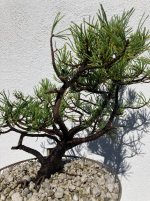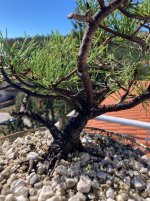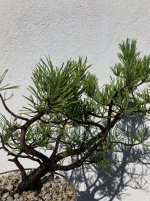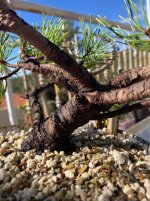Hello,
It has been 4-5 years since i got into bonsai. I have a few chinese elms and junipers that i keep, but not much more since my work required most of my time. Due to a health issue i now have ample time so i bought this leftover mugo for just 5 euros, because i saw a low branch and a good trunk shaped in an angle from the ground, having decent root flare.. I have read vance wood guide on mugos but im still afraid to do much due to inexperience.
After purchasing the tree i repotted it to a colander in pumice as per vance recomendation, no root cutting, just removed 60-70% of the surrounding heavy clay soil, but left the core intact. I also carefully untangled some crossing roots.
I have NOT cut anything above ground, and im making this post for this reason- There is a knuckle of branches there, is it going to develop inverse taper or because its low and there is another branch very low, it thickens the trunk and thats why it has this nice shape?
Should i cut the biggest one or two branches now? I fail to see a decent main line, but maybe im just new.
I am quite satisfied with the trunk thickness, i want to to begin some basic shaping but im lost on Pine development.
i think the only viable front is close to the angle of the photos. Any insight as to trunkline or next steps would be welcome. I can provide more photos
It has been 4-5 years since i got into bonsai. I have a few chinese elms and junipers that i keep, but not much more since my work required most of my time. Due to a health issue i now have ample time so i bought this leftover mugo for just 5 euros, because i saw a low branch and a good trunk shaped in an angle from the ground, having decent root flare.. I have read vance wood guide on mugos but im still afraid to do much due to inexperience.
After purchasing the tree i repotted it to a colander in pumice as per vance recomendation, no root cutting, just removed 60-70% of the surrounding heavy clay soil, but left the core intact. I also carefully untangled some crossing roots.
I have NOT cut anything above ground, and im making this post for this reason- There is a knuckle of branches there, is it going to develop inverse taper or because its low and there is another branch very low, it thickens the trunk and thats why it has this nice shape?
Should i cut the biggest one or two branches now? I fail to see a decent main line, but maybe im just new.
I am quite satisfied with the trunk thickness, i want to to begin some basic shaping but im lost on Pine development.
i think the only viable front is close to the angle of the photos. Any insight as to trunkline or next steps would be welcome. I can provide more photos








